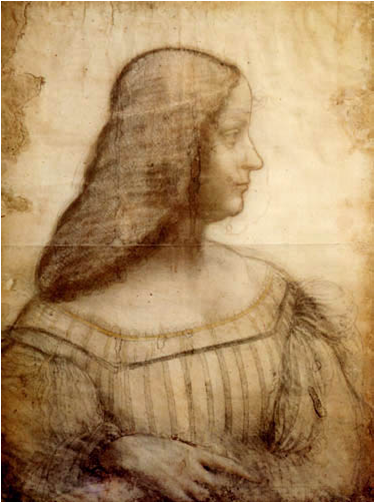 Who was Isabella D’este?
Who was Isabella D’este?
Isabella D’este was Marchesa of Mantua, her husband (Francesco II Gonzaga, Marquess of Mantua) lead the Italian city until his death; Isabella D’este however was not just a spouse, D’este governed Mantua in his absence. D’este therefore represents a significant part of history by being a powerful female, the fact she ruled in his stead shows the type of character D’este was, she is also noteworthy as she was a prolific patron. D’este commissioned many artworks to help the culture of Mantua blossom, this is apparent in her studiolo paintings. D’este’s allegorical and mythological studiolo paintings represent the artistic influence she had on the culture and society of Mantua.
D’este’s studiolo.
Isabella d’Este was famed for her studiolo and grotto and the objects therein. An object in the studiolo would come to reflect the intellectual attributes of the owner and would present a way for the owner’s worldly and scholarly ability to be appreciated. The studiolo was also an interactive persuit, visitors had to find signs of virtue in the objects of the studiolo therefore presenting their knowledge. The possession of ancient virtues was thought to depend on the extent of knowledge of the ancient precedents, and so studying the Classical world became a virtue. The studiolo was where this form of virtuous scholarship was performed. The visitors would generally be those with specific academic understanding, for example poets and humanists, such people would have an understanding of academic subjects such as Greek mythology.
Deste’s paintings.
D’este’s studiolo had five paintings, the room would have been encased by these paintings, creating an inevitable need for close viewing proximity; this inspired the paintings to have acute details and deep meanings. Guests were encouraged to find morals, the paintings would have been viewed by those with specific academic understanding such people would have a deep understanding of academic subjects such as Greek mythology, and so some characters that may be difficult to recognise today would have been immediately identifiable to the crowd of the time.
D’este attempted to commission work from Da Vinci and Bellini however the five paintings in the sequence are: two by Andrea Mantegna, two by Lorenzo Costa and one by Pietro Perugino. This essay will focus on ‘Mars and Venus’ (sometimes titled Parnassus) painted in 1497 by Andrea Mantegna and ‘The Battle of Chastity and Lasciviousness’ painted in 1505 by Pietro Perugino.
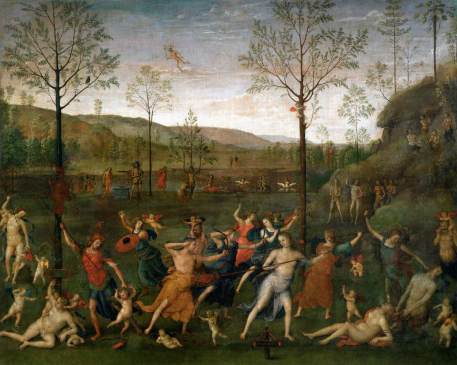
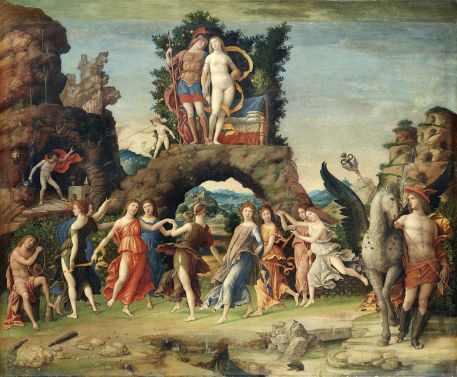
‘Mars and Venus’ is featured first in the sequence and ‘The Battle of Chastity and Lasciviousness’ is third.
Andrea Mantegna.
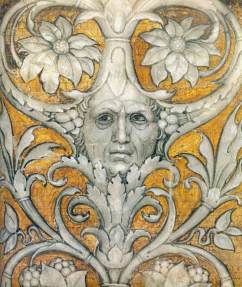
Andrea Mantegna worked for the Marchioness and Marquess of the courts and was on a salary, unlike most artists he was not the artist of a Republic or Pope. The question has to be asked why was Mantegna the only artist commissioned for the studiolo paintings that was in employment; by studying the work he presented we can discover why. Mantegna’s ‘Mars and Venus’ features the Greek Mythological couple Mars (God of war) and Venus (Goddess of love) who are elevated on a natural arch of rock, whilst underneath the nine muses are dancing and are connected in an harmonious loop underneath Mars and Venus. Peace and balance is expressed through the presence of woodland creatures at the bottom of the painting, the animals are not afraid of the people but instead are peeking out. One interpretation is that the paintings represents the Arts flourishing, it is also claimed that Venus’ features are akin to D’este’s and that the painting represents her power over the arts and culture in Mantua and the peace she has brought through supporting them. Mantegna’s presentation of the story shows his power as an artist the painting, masterfully depicted, does not over complicate the narrative.
Pietro Preugino in comparison
 Contrastingly Perugino’s ‘The Battle of Chastity and Lasciviousness’ has a dizzying depiction of a battle between virtue and vice (a theme that runs through all of the studiolo paintings) By close guidance of D’este, Perugino uses Greek mythological characters to represent the moral battle between love and lust. Pallas and Diana represent lust and are in battle with Venus and Cupid, representative of love. Mantegna masterfully presents his story with clear pockets of narrative, where as Perugino’s battle, although presenting confusion, is unsuccessful in producing a legible narrative. It could be argued that Perugino was tailoring his work to D’este’s studiolo by presenting a work that needed to be studied in detail, but in doing so the message becomes aesthetically confused and does not give a striking overall reaction. The viewer is left feeling uneasy as there is no resolution to the combat, with the battle still in process the moral that love conquers is not expressed and so the painting fails to present the crux of the narrative. Similarly Mantegna’s work, although seemingly presenting balance, is challenged by the appearance of Vulcan.
Contrastingly Perugino’s ‘The Battle of Chastity and Lasciviousness’ has a dizzying depiction of a battle between virtue and vice (a theme that runs through all of the studiolo paintings) By close guidance of D’este, Perugino uses Greek mythological characters to represent the moral battle between love and lust. Pallas and Diana represent lust and are in battle with Venus and Cupid, representative of love. Mantegna masterfully presents his story with clear pockets of narrative, where as Perugino’s battle, although presenting confusion, is unsuccessful in producing a legible narrative. It could be argued that Perugino was tailoring his work to D’este’s studiolo by presenting a work that needed to be studied in detail, but in doing so the message becomes aesthetically confused and does not give a striking overall reaction. The viewer is left feeling uneasy as there is no resolution to the combat, with the battle still in process the moral that love conquers is not expressed and so the painting fails to present the crux of the narrative. Similarly Mantegna’s work, although seemingly presenting balance, is challenged by the appearance of Vulcan.
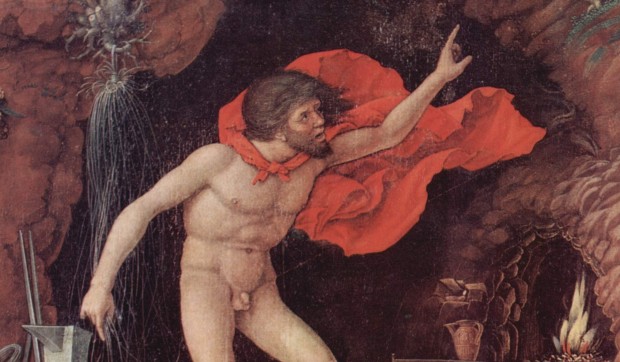
Vulcan is Venus’ husband and the fabricator of fire and metal, his presence makes Mars and Venus’ relations adulterous, a putto is seen to be firing at Vulcan, possibly Cupid son of Venus, adding to the discordance, the dark cave of Vulcan portrays the tempestuous relations. The putto is firing towards Vulcan’s genitals and hanging behind Vulcan are grapes, these both could be referring to sex and extinguishing the flames of passion, like Perugino’s work a battle between love and lust is alluded to.
Both paintings are in a pastoral setting and utilise nature as a tool to help tell the story. In Perugino’s work an olive tree with an owl perched on top which are both symbols referring to Pallas. The second tree, the myrtle represents Venus; these are symbols that D’este and her learned guests would recognise. By positioning the two trees on either side of the canvas, framing Diana and Venus fighting, the two opposing options for the viewer is expressed showing how separate the two choices of vice and virtue are.
Featured in both paintings is Hermes (Mercury), in Mantegna’s work he dominates the right-hand side of the canvas with Pegasus. As the painting was for a Western audience (that reads left to right) although he is depicted the largest, he does not overpower the obvious hierarchy of Mars and Venus. In Perugino’s work Mercury is above the battle, in both paintings he is holding his sceptre, which represents peace. The fact that he is grounded in Mantegna’s work could reinforce the apparent harmony present and explain why in Perugino’s he is above the battle, yet to bring peace and order.
Isabella D’este was a highly educated woman; this is shown in the paintings of her studiolo and her active role in the ruling of Mantua. D’este wanted the result of the series of paintings to be “classical subjects with beautiful meanings” here the artists’ work can be seen to be successfully presented, perhaps Perugino is less successful as D’este was adamant of what had to be included in the work, D’este may however have been so constricting as she knew the ability of the artist was less of that of Mantegna, someone that she felt was talented enough to employ full-time. Both works feature unresolved problems and represent deciding in conflict; Mantegna however presents the scenario that is about to begin rather than Perugino’s approach of showing the most hectic part of the narrative. Mantegna’s vivid approach creates a crisp representation with new details to find with each viewing. Perugino attempts to be expansive to portray the immense battle of vice and virtue; putty and nymphs are en route in the background to come to the aid of Venus, although emotive this however dilutes the narrative and it is unclear as to who is on which side of the battle.







One thought on “A trip to The Louvre sparks an exploration into Isabella D’este and her Studiolo Paintings”